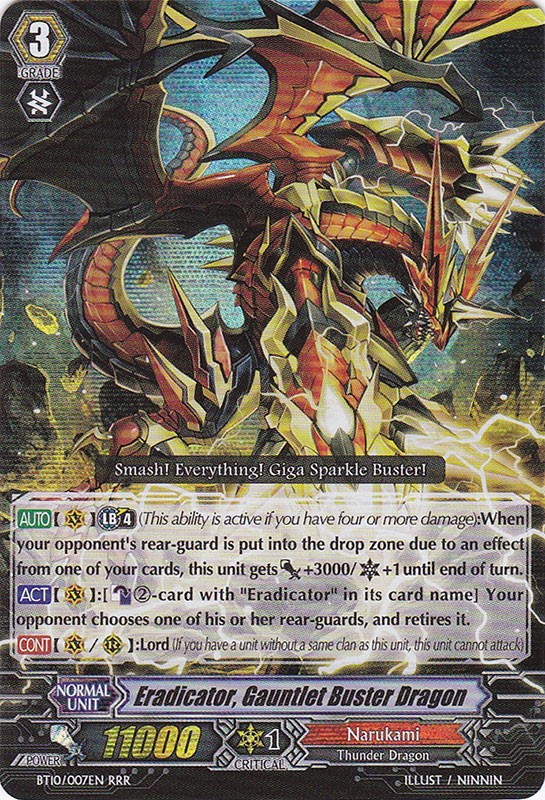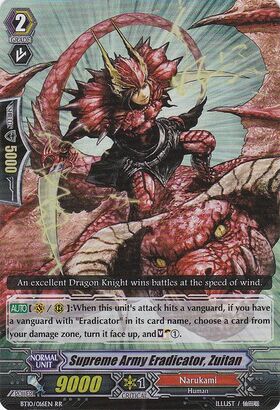[ECG] Deck Check: The Dragon Emperor's Descendant!
Eradicators are an archetype belonging to Narukami that are highly aggressive and possess very heavy field control. They have been sort of playable for the past few months, using cards such as Eradicator, Vowing Sword Dragon and Eradicator, Sweep Command Dragon. However, they are just now entering their prime with their newest English addition: Eradicator, Dragonic Descendant!
The Dragon Emperor's Descendant!
17 / 14 / 11 / 8
1 Spark Kid Dragoon
4 Eradicator, Yellow Gem Carbuncle [Critical]
4 Sacred Spear Eradicator, Pollux [Critical]
2 Eradicator, Dragon Mage [Draw]
2 Eradicator, Blue Gem Carbuncle [Draw]
4 Worm Toxin Eradicator, Seiobo [Heal]
4 Eradicator Wyvern Guard, Guld
4 Eradicator, Demolition Dragon
4 Ceremonial Bonfire Eradicator, Castor
2 Rising Phoenix
4 Eradicator, Spark Rain Dragon
4 Fiendish Sword Eradicator, Chou-Ou
3 Supreme Army Eradicator, Zuitan
3 Eradicator, Dragonic Descendant
3 Eradicator, Gauntlet Buster Dragon
2 Eradicator, Vowing Sword Dragon
From a glance, the deck looks fairly streamlined and is packed with a lot of simple units. It comes with four copies of each power attacker, and it provides draw power through a portion of its grade 1's. Chou-Ou is also a very useful control card, as it can easily get rid of a front row without eating up counterblast. The main power from the deck, however, comes primarily from its boss units.
Eradicator, Dragon Descendant is the first and most important boss, packing a standard 11000 base, but also a terrifying Limit Break. Once you hit four damage, if Descendant attacks and the attack does not hit, you can counterblast one, discard three Eradicators, and stand him. Not only does he gain the ability to attack again, but on top of that, he gains an extra critical. As long as you keep your opponent pressured at high damage, Dragonic Descendant's effect becomes a very dangerous threat. The instances where your opponent would want to keep their vanguard safe are when they're at four or five damage, meaning once they reach these levels, they'll start having to guard an additional vanguard attack.
There are flaws in this card however. When he stands, he doesn't stand the unit behind him. This can make his second attack fairly weak. If you don't check any triggers on the first attack, your opponent usually should be able to block him with a single 10000 guard investment. However, as a fail-safe, Descendant allows you to counterblast two Eradicators to give him an additional +5000 power for the turn. These skills are often neglected for their high cost, but when Descendant's Limit Break only costs one counterblast to begin with, and he needs additional power on the second swing to be relevant, this skill can be handy more often than you think.
People have also turned to Eradicator's Break Ride, Vowing Sword Dragon, as a way to compensate the lack of power. In addition to retiring a front row unit, Vowing Sword Dragon gives your Descendant an additional +10000 power during your Break Ride turn, and this is relevant for Descendant more than almost any Break Ride combo. With these two combined, the turn becomes hell for your opponent, either demanding at least two Sentinels or a whole lot of cards to guard with. However, instead of running a 4:4 split with Descendant and Vowing Sword, I've also decided to make it a 3:3:2 split and run three copies of another Eradicator boss: Gauntlet Buster Dragon.
Gauntlet Buster is the deck's alternate source of power to Dragonic Descendant. His especial counterblast forces your opponent to retire a unit of their choice. At first it doesn't seem worth it, seeing as it costs two and they can always retire a unit they don't value much to begin with, but his Limit Break can make it, along with other cards in your deck, more deadly.
Whenever you retire an opponent's rear guard through a card effect, Gauntlet Buster's Limit Break gives him an additional +3000 power, AND an extra critical. This effect can be applied as many times a turn as you want, and it has no other cost. This means for each card you can retire in a turn, Gauntlet Buster does one more damage. In the right scenarios, this skill has the power to end games all by itself. Even if it's used once, your opponent already has to prioritize their guard for it. It's assumed that we're in the late game and a single powered hit from Gauntlet Buster can mean game over, especially combined with the fact that we're running eight critical triggers.
It's also very easy to trigger Gauntlet Buster in this deck. Vowing Sword Dragon comes into play again, because its Break Ride effect comes in with a retiring skill, while making Gauntlet Buster even harder to guard at the same time! Chou-Ou also synergizes well, because it also gives you an easy retire at the cost of card advantage, as opposed to a counterblast.
So why is it that I chose to play three different grade 3's as opposed to keeping consistent and using two? It's because Dragonic Descendant comes with a sort of phantom flaw. He's only truly effective in the late game, as stated before. You don't want to see him early, especially before something like Vowing Sword Dragon, but you still want him to be there. Gauntlet Buster, however, assists in giving you a better early game. Not only can it turn your damage into advantage easily, it can also force your opponent into the late game faster through its bonus criticals. Since Vowing Sword also synergizes with both of our bosses, it's also beneficial to include, plus it's also a good card to sit on before Limit Break.
With all of these factors combined, the deck can now and then be very hungry for counterblasts. Gauntlet Buster eats up two every time it wants to retire, and Descendant can use up two to make its attack scarier, so what if we need to un-flip damage? This is where Supreme Army Eradicator, Zuitan comes in. While he doesn't offer much in terms of combat, if he hits a vanguard, you get to flip a damage face-up as well as soulcharge one. Want to use Gauntlet Buster some more? Pressure them down with Zuitan. He can end up being irritating in certain situations. He doesn't provide the most pressure, but he opens up game states where you can make more out of your damage zone. He also helps fuel your copies of Rising Phoenix, in the odd scenarios where you can't afford the soul for them.
Looking into Eradicators a bit more, they have Eradicator, Strike-dagger Dragon, a starting vanguard who has the ability to Superior Ride Dragonic Descendant from the deck. This seems cool and all, but I don't prefer it at all. I already use Zuitan, one of the two components necessary, but playing Sword Dance Eradicator, Hisen can be a liability. Being able to make 22000 columns with Descendant can be powerful, but the 6000 power is difficult to rely, on especially with all my 9000 grade 2's. And on top of that, I already talked about how Descendant has little to no influence on the early game, so having him on turn two as opposed to later in the game is more of a hindrance than a benefit.
Eradicators also have Ambush Dragon Eradicator, Linchu. Linchu is useful because he can trade himself to retire a grade 1 or lower unit if it boosts and hits. Linchu is a good option for the deck, especially considering the starting vanguards you can kill with it, but I favor the consistency of Spark Kid Dragoon to get the grade 3 that I need. If you feel you don't need Spark Kid Dragoon's effect, Linchu is the next best thing.
I've seen some Eradicator builds that use Eradicator, Sweep Command Dragon over Vowing Sword Dragon or Gauntlet Buster Dragon as an alternate boss monster. Sweep Command can offer benefits to your deck, as it is a bit more of a retire heavy boss than the others. When you ride Sweep Command Dragon, you can send an Eradicator from your field to the soul to retire a front row, and then you can use his Limit Break to retire another front row and draw. This card can generate a lot of advantage on its own, at the cost of being dependent on the late game. However, he is very valuable vs match-ups that have threatening front row units. Not to mention he can effectively shut down intercepts during the turn you ride him, which can setup potential kill turns. I personally don't mind the unit, but I would not try to incorporate all four bosses into the deck, as this will most likely lead to inconsistencies.
As far as match-ups for the Eradicator deck go, you have easier times vs fragile decks that rely on their rear guards to succeed. Scary units such as Silent Tom, Palamedes and such lose their effectiveness due to how easy they are to retire. There are some match-ups where Gauntlet Buster becomes a very awkward card, since cards like Stamp Sea Otter and many of the Tachikaze have the ability to survive him. Since your opponent chooses what to retire with Gauntlet Buster's effect, they can direct the skill to certain units that either stick to the field regardless or give them some sort of advantage as compensation, so be careful when using it. The deck can also capitalize vs decks that rely deep into the late game. You can let decks go to four or five damage, as long as you can survive them, because a Dragonic Descendant drop in the following turn has the potential to secure the game for you. With these tips in mind, I hope that you can bring this deck to the playing field and rule over others with Dragonic Descendant. Feel free to make your own changes to the build, as no build is perfect, and as always, thanks for reading.


.jpg)
.jpg)


.jpg)




0 comments:
Post a Comment